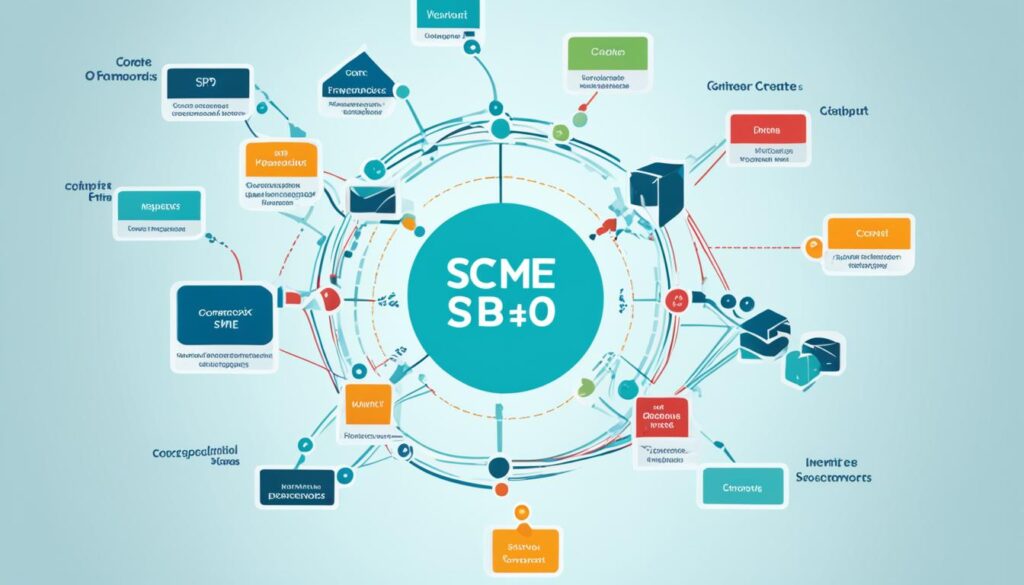The NIST SP800-37 Risk Management Framework is a powerful tool that can be customized to meet the unique needs of small and medium-sized enterprises (SMEs) in the realm of cybersecurity. As an experienced professional in the field, we understand the challenges that SMEs face when it comes to managing cybersecurity risks with limited resources. In this article, we will provide actionable insights on how to tailor the NIST SP800-37 framework to your SME’s needs, ensuring the success and protection of your critical business operations.
The bulleted list will include:
– Customizing the NIST SP800-37 framework to align with the specific needs and risks of your SME
– Utilizing the NIST Framework website as a valuable resource for guidance and templates
– Understanding the five functions of the NIST Framework: Identify, Protect, Detect, Respond, and Recover
– Implementing framework profiles and implementation tiers to assess and improve your cybersecurity posture
– Compliance requirements for SMEs and the benefits of demonstrating commitment to cybersecurity
– The collaborative development process of the NIST Framework and its relevance in the current cybersecurity landscape
– The three main components of the NIST Framework: Framework Core, Framework Profiles, and Framework Implementation Tiers
– The importance of security risk management in organizations and guidance provided by NIST SP 800-39
– The unique risk management and cybersecurity challenges faced by SMEs
– Practical implementation challenges for SMEs and the need for tailored risk management approaches
– The conclusion that the NIST Framework is a valuable tool for SMEs, with a focus on further research to address challenges and develop practical solutions
Understanding the NIST Framework
The NIST Framework is a comprehensive cybersecurity framework based on existing standards, guidelines, and practices. It serves as a valuable resource for organizations, including small businesses, seeking to enhance their cybersecurity defenses. Unlike a rigid checklist, the NIST Framework focuses on desired outcomes, allowing organizations to tailor their cybersecurity approach to address their specific risks and needs.
Designed to foster effective communication and collaboration, the NIST Framework encourages internal and external stakeholders to work together towards a common goal of mitigating cybersecurity risks. By implementing the framework, organizations can establish a strong foundation for cybersecurity and improve their overall resilience.
The Five Functions of the NIST Framework
The NIST Framework is structured around five core functions, each addressing different aspects of cybersecurity:
- Identify: This function involves understanding the organization’s assets, identifying potential threats, and assessing vulnerabilities.
- Protect: Organizations implement safeguards to prevent or limit the impact of cybersecurity events.
- Detect: Organizations establish capabilities to identify cybersecurity events in a timely manner.
- Respond: Organizations develop and implement response plans to effectively address and mitigate cybersecurity incidents.
- Recover: This function focuses on restoring and improving operations after a cybersecurity incident and ensuring the organization’s resilience.
By addressing each of these functions, organizations can create a comprehensive cybersecurity strategy that covers prevention, detection, response, and recovery.
Profiles and Implementation Tiers
In addition to the five core functions, the NIST Framework includes profiles and implementation tiers to further enhance its customization and applicability to different organizations:
- Profiles: With profiles, organizations can align their cybersecurity objectives with their business requirements. By selecting relevant outcomes and activities from the framework, organizations can prioritize their efforts and focus on the areas that are most critical to their operations.
- Implementation Tiers: The implementation tiers provide a means for organizations to assess and communicate their cybersecurity posture. Each tier represents different levels of cybersecurity maturity, enabling organizations to gauge their progress and establish a roadmap for improvement.
Together, profiles and implementation tiers allow organizations to measure and communicate their cybersecurity capabilities and track their progress over time.
NIST Framework and Small Businesses
While the NIST Framework may seem complex, it is designed to be adaptable and accessible to organizations of all sizes, including small businesses. By leveraging the framework, small businesses can develop robust cybersecurity practices that are tailored to their unique needs and resources. Implementing the NIST Framework can help small businesses protect their sensitive data, safeguard their systems, and build trust with their customers and partners.
By applying the guidelines provided in the NIST SP800 series, small businesses can enhance their cybersecurity posture and establish a solid foundation for their digital operations. The NIST Framework empowers small businesses to address cyber threats effectively and stay ahead of potential risks in an ever-evolving digital landscape.
| Benefits of Implementing the NIST Framework for Small Businesses |
|---|
| Improved cybersecurity posture |
| Enhanced protection of sensitive data |
| Greater resilience to cyber threats |
| Increased customer and partner trust |
| Alignment with industry best practices |
Getting Started with the Framework
When it comes to implementing the NIST Framework, organizations can easily get started by visiting the NIST Framework website. This website serves as a comprehensive resource hub, offering a wealth of information and tools to guide organizations through the implementation process.
One of the key resources provided is the Framework Quick Start Guide. This guide offers clear direction and guidance for organizations looking to adopt and implement the framework. It outlines the essential steps, activities, and considerations involved in aligning cybersecurity efforts with the NIST Framework.
Another valuable tool available on the NIST Framework website is the Resource Repository. This repository offers a wide range of approaches, methodologies, case studies, and templates that organizations can leverage to customize the framework according to their unique needs and requirements. It provides practical examples and resources to help organizations better understand and apply the principles of the framework in their specific context.
Additionally, the NIST Framework website provides educational materials and links to external resources, allowing organizations to dive deeper into cybersecurity best practices and stay up to date with the latest industry developments.
Key Resources on the NIST Framework Website
| Resource | Description |
|---|---|
| Framework Quick Start Guide | A comprehensive guide offering step-by-step directions for implementing the NIST Framework. |
| Resource Repository | A repository containing a variety of resources, including approaches, methodologies, case studies, and templates. |
| Educational Materials | A collection of educational resources for organizations looking to enhance their cybersecurity knowledge and skills. |
| External Links | Curated links to external websites and resources that provide additional insights and best practices. |
By leveraging the resources available on the NIST Framework website, organizations can kickstart their journey towards implementing effective cybersecurity risk management practices that align with industry standards and best practices.
Framework Compliance Requirements

While the NIST Framework is voluntary, some organizations may be required to use it. Executive Order 13800 made the Framework mandatory for U.S. federal government agencies, and several federal, state, and foreign governments have also made it mandatory for specific sectors or purposes. Additionally, some organizations may require their suppliers or customers to adhere to the NIST Framework as part of their supply chain cybersecurity requirements. Compliance with the framework can help organizations demonstrate their commitment to cybersecurity and meet regulatory obligations.
Ensuring compliance with cybersecurity regulations is crucial for protecting organizational assets and maintaining the trust of stakeholders. The NIST Framework offers a comprehensive set of guidelines that can be tailored to the specific needs and risks of an organization. By aligning their practices with NIST compliance requirements, organizations can enhance their IT security posture and effectively manage cybersecurity risks.
The Benefits of NIST Compliance
Compliance with the NIST Framework brings several advantages to organizations:
- Enhanced cybersecurity: By following the recommendations of the NIST Framework, organizations can adopt best practices for identifying, protecting, detecting, responding to, and recovering from cybersecurity incidents.
- Regulatory compliance: Many regulatory bodies recognize the NIST Framework as a reliable standard for cybersecurity. Compliance with the framework can help organizations satisfy regulatory requirements and avoid penalties.
- Supply chain security: Adhering to the NIST Framework can also facilitate secure collaboration with suppliers, ensuring that the entire supply chain maintains a high level of cybersecurity.
- Improved risk management: The NIST Framework provides a systematic approach to risk management, helping organizations assess the potential impact of cybersecurity threats and implement appropriate controls.
Challenges of Framework Compliance
While NIST compliance offers significant benefits, organizations may face challenges in achieving and maintaining compliance:
- Complexity: The NIST Framework consists of multiple components and guidelines, requiring a thorough understanding and implementation.
- Resource constraints: Small and medium-sized enterprises (SMEs) may have limited resources and expertise to fully comply with the framework.
- Dependency on third parties: Organizations relying on other entities in their supply chain need to ensure their partners adhere to NIST compliance requirements.
- Evolution of cybersecurity threats: Compliance with the NIST Framework requires organizations to stay up to date with emerging cybersecurity risks and adapt their practices accordingly.
Addressing these challenges requires a proactive and comprehensive approach to cybersecurity governance and risk management. Organizations should prioritize cybersecurity investments, collaborate with stakeholders, and continuously assess and improve their compliance efforts.
Frameworks and Regulations
Compliance with the NIST Framework aligns organizations with various cybersecurity regulations, including:
| Regulation | Description |
|---|---|
| Executive Order 13800 | Makes the NIST Framework mandatory for U.S. federal government agencies. |
| European Union General Data Protection Regulation (GDPR) | Requires organizations handling EU citizens’ data to implement appropriate security measures. |
| Financial Industry Regulatory Authority (FINRA) Cybersecurity Framework | Mandates cybersecurity controls for financial institutions to protect sensitive customer information. |
| Health Insurance Portability and Accountability Act (HIPAA) | Sets security standards for protecting individuals’ health information. |
| Payment Card Industry Data Security Standard (PCI DSS) | Requires organizations handling cardholder data to maintain secure environments. |
Compliance with the NIST Framework can serve as a foundation for meeting these and other cybersecurity regulations, enabling organizations to navigate the complex landscape of IT security requirements while safeguarding their operations and data.
The Framework Development Process
The NIST Framework for cybersecurity risk management was developed through a comprehensive and collaborative process, engaging thousands of stakeholders from industry, academia, and government. We value the input from stakeholders as it ensures the framework’s relevance and effectiveness.
NIST actively engages stakeholders through various channels, including workshops, solicitations for feedback, and observations of relevant resources from government, academia, and industry. This collaborative approach allows us to gather diverse perspectives and insights, ensuring that the framework addresses the real-world challenges faced by organizations.
Over time, the framework has undergone several updates based on new insights and feedback. To provide transparency and accessibility, NIST maintains a development archive that documents the evolution of the framework. This archive serves as a valuable resource for understanding the framework’s journey and the rationale behind its various components.
Our commitment to stakeholder engagement extends beyond the development process. NIST continues to collaborate with stakeholders to ensure that the framework remains up to date and aligned with emerging cybersecurity challenges. We appreciate the ongoing contributions and feedback from the cybersecurity community.
Framework Development Process Overview
The framework development process can be summarized as follows:
- Engagement: NIST engages with stakeholders through workshops, solicitations for feedback, and resource observations.
- Updates: The framework is regularly updated to incorporate new insights and feedback from stakeholders.
- Development Archive: NIST maintains a development archive to provide transparency and accessibility.
- Ongoing Engagement: NIST continues to collaborate with stakeholders to ensure the framework remains relevant and effective.
The collaborative nature of the framework development process ensures that it reflects the collective expertise and experiences of the cybersecurity community. Through stakeholder engagement, NIST promotes a framework that is dynamic, adaptable, and responsive to evolving cybersecurity risks and challenges.
| NIST Framework Development Process | Description |
|---|---|
| Engagement | NIST engages with stakeholders through workshops, solicitations for feedback, and resource observations. |
| Updates | The framework is regularly updated to incorporate new insights and feedback from stakeholders. |
| Development Archive | NIST maintains a development archive to provide transparency and accessibility. |
| Ongoing Engagement | NIST continues to collaborate with stakeholders to ensure the framework remains relevant and effective. |
Framework Components

The NIST Framework for cybersecurity risk management consists of three main components: the Framework Core, Framework Profiles, and Framework Implementation Tiers. Each component plays a vital role in helping organizations tailor their cybersecurity strategies to their specific needs and risk levels.
Framework Core
The Framework Core forms the foundation of the NIST Framework, providing a comprehensive set of cybersecurity activities, desired outcomes, and references that are applicable across various sectors. It is organized into functions, categories, and subcategories, offering a structured approach to managing cybersecurity risks.
With the Framework Core, organizations can identify and address the critical areas of cybersecurity based on their unique requirements. By following the functions, categories, and subcategories, companies can establish a robust cybersecurity framework that aligns with industry-leading practices.
Framework Profiles
Framework Profiles enable organizations to customize the NIST Framework to their specific business needs and objectives. A Framework Profile represents an organization’s chosen set of cybersecurity outcomes, aligning with their desired risk management approach. These profiles serve as a valuable tool for assessing an organization’s current cybersecurity posture and establishing target outcomes.
By defining Framework Profiles, organizations can prioritize and focus their cybersecurity efforts on the areas that are most relevant to their operations. This customization allows for greater efficiency in implementing the NIST Framework and ensures that cybersecurity efforts are aligned with business goals.
Framework Implementation Tiers
The Framework Implementation Tiers provide context on how an organization manages and reduces cybersecurity risks based on their risk management processes, available resources, and desired outcomes. These tiers help organizations assess their current cybersecurity maturity level and determine the appropriate steps for improvement.
Organizations can use the Framework Implementation Tiers to evaluate their current risk management practices and identify areas for enhancement. By progressing through the tiers, organizations can strengthen their cybersecurity defenses, allocate resources more effectively, and better align their risk management efforts with their overall business strategy.
| Framework Component | Description |
|---|---|
| Framework Core | Provides a comprehensive set of cybersecurity activities, outcomes, and references that are applicable across sectors. |
| Framework Profiles | Enables organizations to customize the NIST Framework by selecting cybersecurity outcomes based on their business needs. |
| Framework Implementation Tiers | Provides context on how an organization manages cybersecurity risks based on their risk management processes, resources, and desired outcomes. |
Security Risk Management in Organizations
Security risk management plays a crucial role in an organization’s cybersecurity efforts. Implementing effective security risk management strategies can help organizations identify and mitigate potential risks to their information systems and critical business operations.
Risk Framing
Risk framing involves establishing the governance structure and risk management strategy at the organization level. It helps define the organization’s risk appetite, determine risk tolerance levels, and align risk management efforts with business objectives. By framing risks within a strategic framework, organizations can prioritize their resources and focus on addressing the most critical risks.
Risk Assessment
Risk assessment is a critical step in security risk management. It involves identifying and assessing threats, vulnerabilities, and potential impacts to the organization. By conducting a comprehensive risk assessment, organizations can gain insights into their current security posture and identify areas of improvement. This process enables organizations to make informed decisions about allocating resources to address the identified risks.
Risk Response
Risk response involves developing appropriate courses of action to address identified risks. This includes determining whether to accept, avoid, mitigate, share, or transfer the risk. Organizations need to evaluate the costs and benefits associated with each response option and select the most effective and efficient approach to manage the risks. By implementing effective risk response strategies, organizations can minimize the impact of potential security incidents and protect their valuable assets.
Risk Monitoring
Risk monitoring is a continuous process that ensures the effectiveness of risk management efforts. It involves regularly assessing and reevaluating the identified risks to determine if any changes have occurred. By monitoring risks on an ongoing basis, organizations can detect emerging threats, identify new vulnerabilities, and adapt their risk management strategies accordingly. This proactive approach helps organizations stay ahead of potential security breaches and maintain a robust security posture.
Overall, NIST SP 800-39 provides valuable guidance on implementing security risk management in organizations. By incorporating risk framing, risk assessment, risk response, and risk monitoring into their cybersecurity practices, organizations can effectively manage and mitigate risks to their information systems and critical business operations.
Risk Management Challenges for SMEs
Small and medium-sized enterprises (SMEs) face unique challenges when it comes to risk management and cybersecurity. Limited resources and expertise can make it difficult for SMEs to implement comprehensive risk management processes. Many existing frameworks and best practices are tailored to larger organizations, leaving SMEs without adequate guidance. However, it is crucial for SMEs to prioritize risk management to protect their critical business operations. Understanding and addressing the specific challenges faced by SMEs can help improve their cybersecurity posture.
SME Cybersecurity Challenges
When it comes to cybersecurity, SMEs encounter several challenges that set them apart from larger organizations. These challenges include:
- Limited Resources: SMEs often have fewer personnel, smaller budgets, and less sophisticated IT infrastructure compared to their larger counterparts. This limited resource allocation can impede their ability to establish robust cybersecurity measures.
- Lack of Expertise: SMEs may not have dedicated cybersecurity professionals on staff or the financial means to hire external experts. This can result in a lack of knowledge and understanding of cybersecurity best practices.
- Inadequate Training and Awareness: SME employees may not receive sufficient cybersecurity training, leaving them vulnerable to social engineering attacks and other cybersecurity threats.
- Supply Chain Risks: SMEs are often interconnected with larger organizations as suppliers or service providers. This exposes them to potential cybersecurity risks from their business partners.
Risk Management in SMEs
Despite these challenges, SMEs must prioritize risk management to protect their critical business operations. By identifying and addressing the specific challenges faced by SMEs, organizations can develop effective risk management strategies. Some key considerations for risk management in SMEs include:
- Resource Allocation: SMEs should carefully allocate their limited resources to key cybersecurity areas, such as implementing robust security measures, employee training, and incident response capabilities.
- Collaboration and Information Sharing: SMEs can benefit from collaborating with industry associations and peers to share cybersecurity best practices, insights, and lessons learned.
- Outsourcing and Partnerships: SMEs can leverage external expertise through outsourcing or partnering with managed security service providers (MSSPs) to enhance their cybersecurity capabilities.
- Continuous Monitoring and Assessment: Regular risk assessments, vulnerability scans, and security audits can help SMEs identify and mitigate emerging threats and vulnerabilities.
Implementing these risk management strategies can help SMEs improve their cybersecurity posture, safeguard their business operations, and gain the trust of customers, partners, and stakeholders.
Practical Implementation Challenges for SMEs
A case study conducted with upper management participants from three SMEs highlighted several practical challenges when it comes to implementing risk management. These challenges pose significant obstacles for small and medium-sized enterprises (SMEs) in effectively managing their cybersecurity risks.
- The first challenge that SMEs face is limited resources. As compared to larger organizations, SMEs often have fewer financial and human resources dedicated to risk management. This scarcity makes it challenging to implement comprehensive risk management processes and invest in cybersecurity measures.
- The second challenge is the lack of knowledge and expertise in risk management. Many SMEs do not have dedicated risk management teams or individuals with specialized skills in this domain. As a result, they struggle to identify, assess, and mitigate potential risks effectively.
- Prioritizing risks based on business goals and experiences is another challenge for SMEs. With limited resources, SMEs need to allocate their efforts strategically. However, the lack of clear guidelines and frameworks tailored to SMEs makes it difficult for them to identify and prioritize the most critical risks that could impact their business operations.
- Furthermore, SMEs often lack formal risk management processes. Without structured frameworks in place, they may rely on ad-hoc approaches or overlook certain risks altogether. This can leave them vulnerable to cyber threats and make it difficult for them to respond effectively in case of an incident.
- Finally, SMEs may underestimate the importance of cybersecurity. They may perceive cybersecurity as something primarily relevant to larger organizations or fail to recognize the potential impact of cyber incidents on their own business operations and reputation.
This case study highlights the pressing need for practical and tailored risk management approaches that suit the unique resources and needs of SMEs. Developing strategies and best practices specifically designed for SMEs can significantly improve their cybersecurity posture and help protect their critical business operations.
Practical Implementation Challenges for SMEs
| Challenges | Description |
|---|---|
| Limited Resources | SMEs often have fewer financial and human resources dedicated to risk management. |
| Lack of Knowledge and Expertise | Many SMEs do not have individuals with specialized skills in risk management. |
| Prioritizing Risks | SMEs struggle to identify and prioritize the most critical risks based on business goals. |
| Lack of Formal Processes | SMEs may lack structured frameworks and rely on ad-hoc approaches to risk management. |
| Underestimating Cybersecurity Importance | SMEs may not fully recognize the potential impact of cyber incidents on their business operations. |
Further research in this area can provide valuable insights and recommendations to address these challenges and support SMEs in effectively managing their cybersecurity risks.
Conclusions and Future Research
In conclusion, the NIST Framework offers a valuable tool for organizations, including small and medium-sized enterprises (SMEs), to effectively manage cybersecurity risks. By customizing the framework to their specific needs, SMEs can enhance their cybersecurity posture and safeguard their critical business operations.
However, implementing risk management in SMEs presents unique challenges, such as limited resources and awareness. To overcome these hurdles, further research is essential. Future studies should aim to address these challenges by developing practical solutions and best practices that are specifically tailored to the needs of SMEs, particularly in the areas of risk assessment, risk response, and risk monitoring.
By conducting rigorous research and analysis in SME risk management, we can empower these organizations to effectively mitigate and address cybersecurity risks. This research will enable SMEs to make informed decisions, allocate their limited resources efficiently, and enhance their overall cybersecurity resilience.
In summary, the NIST Framework provides a solid foundation for SMEs to navigate the complex cybersecurity landscape. Moving forward, it is crucial to invest in future research that focuses on developing targeted strategies and innovative approaches to bolster risk management capabilities in SMEs.







